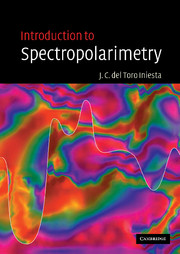Book contents
- Frontmatter
- Contents
- Preface
- Acknowledgements
- 1 Historical introduction
- 2 A review of some basic concepts
- 3 The polarization properties of quasi-monochromatic light
- 4 Linear optical systems acting on polarized light
- 5 Solar polarimetry
- 6 Absorption and dispersion
- 7 The radiative transfer equation
- 8 The RTE in the presence of a magnetic field
- 9 Solving the radiative transfer equation
- 10 Stokes spectrum diagnostics
- 11 Inversion of the RTE
- Index
3 - The polarization properties of quasi-monochromatic light
Published online by Cambridge University Press: 11 August 2009
- Frontmatter
- Contents
- Preface
- Acknowledgements
- 1 Historical introduction
- 2 A review of some basic concepts
- 3 The polarization properties of quasi-monochromatic light
- 4 Linear optical systems acting on polarized light
- 5 Solar polarimetry
- 6 Absorption and dispersion
- 7 The radiative transfer equation
- 8 The RTE in the presence of a magnetic field
- 9 Solving the radiative transfer equation
- 10 Stokes spectrum diagnostics
- 11 Inversion of the RTE
- Index
Summary
If light is man's most useful tool, polarized light is the quintessence of utility.
—W. A. Shurcliff, 1962.So far, the polarization properties of the simplest conceivable electromagnetic radiation have been described. However, building a polarization theory that is useful in the real world necessarily requires the consideration of light whose spectrum contains a continuous distribution of monochromatic plane waves within a finite width of frequencies. Heisenberg's uncertainty principle implies infinite time intervals for detecting purely monochromatic light (in other words, we can simply say that monochromatic light does not exist in reality). In this section we shall see that the concept of polarization is also applicable to polychromatic light. As a matter of fact, polychromatic light may share the properties of totally polarized radiation and hence be indistinguishable from monochromatic light in so far as polarimetric measurements are concerned. The coherency matrix and the Stokes parameters can also be defined for a polychromatic light beam, although the binding conditions (2.18) for C and (2.22) for I, Q, U, and V will be slightly modified and the new concepts of partial polarization and degree of polarization will naturally come into play.
Polychromatic light as a statistical superposition of monochromatic light
Under the hypotheses of linearity, stationarity, and continuity, one can assume any polychromatic light beam to be the superposition of monochromatic, time-harmonic plane waves of different frequencies within an interval of width Δv around a central frequency v0.
- Type
- Chapter
- Information
- Introduction to Spectropolarimetry , pp. 19 - 35Publisher: Cambridge University PressPrint publication year: 2003



